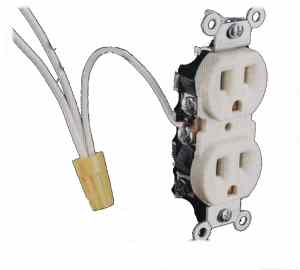Tessiem:
This is probably the easiest question asked in this forum during the time I've been here. However, it's fair to warn you that depending on the kind of hard wired lamp you have in your dining room now, it might not be smart to do what you're wanting to do.
The reason why is that in older homes, ceiling mounted light fixtures that don't allow for air to circulate around the bulb will have the heat from the bulb rise up into the electrical box inside the ceiling above the light fixture. That heat can bake the insulation on the wiring so that it's brittle and will crack and break to pieces if you bend the wires inside the electrical box. If that happens, then a small problem becomes a major problem because if the insulation breaks off the wires and any of those wires touches the metal electrical box, you will keep tripping breakers or blowing fuses to that electrical box until the problem is corrected, and usually that would mean cutting open the ceiling to rewire the electrical box with new wiring. So, if you have a relatively new home, you don't have to worry about this. But, if it's an older house, then I'd either leave your chandelier as a "plug in" or hire an electrician to install it in your dining room. Most likely, that electrician would cut the wires from the existing light fixture and connect your new chandelier to those wires rather than start messing with the old wires.
Anyhow, to answer your question...
110 volt power is distributed in houses via a black power wire and a red power wire. Both the black power wire and the red power wire each carry 110 volts AC, but they are out of phase by 180 degrees, so that if you want to make a 220 volt circuit for an electric dryer or a stove, you would connect the dryer or stove between the red and black power wires. If you want to make a 110 volt circuit for an electric outlet, or a ceiling lamp, you would connect the electric outlet or ceiling lamp between either the red or black power wire and the white neutral wire.
So, your ceiling light fixture will be screwed to an electrical box inside your ceiling. Inside that electrical box you can expect to see a black or red power wire and a white neutral wire.
On your chandelier, each porcelain socket has one black wire and one white wire coming from it.
To have your switch turn on your chandelier, you would simply connect the white wire in the electrical box to all of the white wires from the porcelain sockets. And, you would connect the black or red power wire in the electrical box to all the black wires coming from the porcelain sockets.
Now, normally the way you would actually do this is with something called "pigtails":
In the picture above, the wire that connects the two white wires to the electrical outlet is called a "pigtail". It's a way of connecting multiple wires to the same point.
In your case, if you had 6 light bulbs on your chandelier, for example, you could connect the black wires from three porcelain sockets and one black pigtail wire together. Then you could connect the black wires from the other three porcelain sockets and another black pigtail wire together. Then you would connect those two black pigtail wires together with the RED or BLACK power wire in the electrical box in the ceiling.
In that way, the red or black power wire in the electrical box would be connected to the black wire coming from each porcelain socket.
As long as each black wire from a porcelain socket somehow connects to the red or black power line in the ceiling electrical box, then it's cool.
And, you'd do exactly the same thing with the white wires from the porcelain sockets to connect them all to the white wire in the electrical box in the ceiling. It doesn't matter how many pigtails you use, as long as you have room for the wiring in your chandelier base, it's cool.
And, then once you screw your chandelier base to the electrical box in the ceiling, you'd be able to use the existing switch to turn your chandelier on and off.
Hope this helps.
 I want to make a hanging light for my dining room. The directions call for porcelain sockets with attached wires (one black and one white). The directions also require an extension cord and each socket is tied into the extenion cord with the outlet head cut off and wires matched. With the directions given, it sounds simple. My dilemna is that, I would like to make this lamp one that can be attached to the ceiling that presently has a hardwired light. How can I change the directions to make it a hard wire lamp, and not a plug in? Is this even possible?
I want to make a hanging light for my dining room. The directions call for porcelain sockets with attached wires (one black and one white). The directions also require an extension cord and each socket is tied into the extenion cord with the outlet head cut off and wires matched. With the directions given, it sounds simple. My dilemna is that, I would like to make this lamp one that can be attached to the ceiling that presently has a hardwired light. How can I change the directions to make it a hard wire lamp, and not a plug in? Is this even possible?




